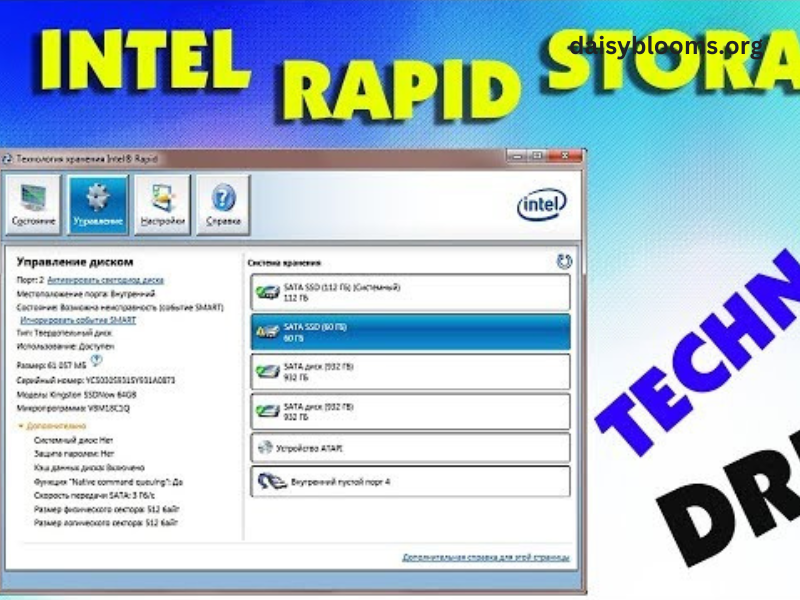In today’s fast-paced digital landscape, optimizing system performance is crucial for both everyday users and professionals alike. One technology that significantly enhances storage capabilities and overall system efficiency is the Intel Rapid Storage Technology (IRST) Driver. This article delves into the features, benefits, and functionalities of the Intel Rapid Storage Technology Driver, explaining how it can transform your computing experience.
What is Intel Rapid Storage Technology?
Intel Rapid Storage Technology is a software solution that provides advanced features for managing storage devices. It is particularly beneficial for systems using Intel chipsets, offering a variety of functionalities that enhance the performance and reliability of storage devices. IRST is designed to improve data management, optimize disk performance, and ensure data integrity, making it an essential tool for both personal and professional users.
Key Features of Intel Rapid Storage Technology Driver
RAID Support
One of the most prominent features of IRST is its support for RAID (Redundant Array of Independent Disks) configurations. RAID allows users to combine multiple drives into a single logical unit, which can enhance performance, provide redundancy, and improve data integrity.
Improved Data Transfer Rates
IRST optimizes data transfer rates between the system and storage devices. By efficiently managing how data is written and retrieved, users can experience faster loading times for applications, games, and large files.
Hot Plugging
With the IRST Driver, users can easily add or replace storage devices without shutting down the system. This feature is particularly advantageous for professionals who require high availability and minimal downtime.
S.M.A.R.T Monitoring
Self-Monitoring, Analysis, and Reporting Technology (S.M.A.R.T) is integrated within IRST. It continuously monitors the health of storage devices and provides alerts regarding potential failures, allowing users to take preventive action before data loss occurs.
Intel Smart Response Technology
This feature enhances system responsiveness by using a small SSD as a cache for frequently accessed data. The IRST Driver intelligently learns usage patterns and optimizes data access, resulting in improved system performance.
Enhanced Security
Intel Rapid Storage Technology also incorporates advanced security features, such as drive encryption and secure boot capabilities. This ensures that sensitive data remains protected from unauthorized access.
Benefits of Using Intel Rapid Storage Technology Driver
Increased Performance: The most significant advantage of using the IRST Driver is the noticeable boost in overall system performance. Users experience faster boot times, improved application load times, and smoother multitasking capabilities.
Data Redundancy
By utilizing RAID configurations, users can safeguard against data loss. In the event of a drive failure, RAID can ensure that data remains accessible through redundancy, minimizing the risk of data loss.
Simplified Storage Management
The IRST interface is user-friendly, allowing users to easily manage and configure their storage devices. This simplifies the process of setting up RAID arrays, monitoring disk health, and managing storage resources.
Future-Proofing
As technology continues to evolve, having a robust storage management solution like IRST helps ensure that systems remain compatible with emerging storage technologies, such as NVMe SSDs and larger-capacity drives.
Seamless Integration
Intel Rapid Storage Technology integrates smoothly with existing Intel-based systems, providing a seamless experience for users without the need for complex configurations.
Installing the Intel Rapid Storage Technology Driver
Installing the Intel Rapid Storage Technology Driver is a straightforward process. Here’s how to do it:
Download the Driver
Visit the official Intel website or your motherboard manufacturer’s support page to download the latest version of the IRST Driver.
Prepare for Installation
Before installation, ensure that your system meets the hardware requirements and that you have backed up any critical data.
Run the Installer
Locate the downloaded file and run the installer. Follow the on-screen prompts to complete the installation process.
Configure the Driver
After installation, open the Intel Rapid Storage Technology interface to configure your storage settings. Here, you can set up RAID arrays, enable caching, and monitor the health of your drives.
Restart Your System
Once the configuration is complete, restart your system to ensure that all changes take effect.
Troubleshooting Common Issues with Intel Rapid Storage Technology Driver
While Intel Rapid Storage Technology is a powerful tool, users may encounter issues during its use. Here are some common problems and their solutions:
Driver Not Recognized
If the IRST Driver is not recognized after installation, ensure that you have the correct version for your operating system and chipset. Reinstalling the driver may also help.
RAID Array Issues
If your RAID array is not functioning correctly, verify that all drives are properly connected and functioning. Use the S.M.A.R.T monitoring feature to check the health of each drive.
Performance Drops
If you notice a drop in performance, consider reviewing your caching settings and ensuring that the SSD used for caching is functioning correctly.
Data Loss
In the rare event of data loss, utilize backup solutions and restore points to recover lost files. Regularly backing up important data is crucial for data integrity.
Best Practices for Maximizing Intel Rapid Storage Technology Driver
To get the most out of your Intel Rapid Storage Technology Driver, consider the following best practices:
Regular Updates
Keep your IRST Driver up to date by regularly checking for new versions. Updates often include performance improvements and security patches.
Monitor Drive Health
Utilize the S.M.A.R.T monitoring feature to keep an eye on the health of your drives. Address any issues promptly to prevent data loss.
Configure RAID Wisely
If setting up RAID, choose the configuration that best suits your needs, whether it be RAID 0 for performance or RAID 1 for redundancy.
Backup Regularly
Despite the reliability of IRST, always maintain regular backups of important data. Use cloud storage or external drives to ensure data safety.
Optimize Caching
Make use of Intel Smart Response Technology to optimize your system’s responsiveness. Choose the right SSD for caching based on your usage patterns.
The Future of Intel Rapid Storage Technology
As technology continues to evolve, Intel Rapid Storage Technology is poised to adapt and grow. Future updates are likely to include support for newer storage technologies, enhanced performance capabilities, and additional features aimed at improving user experience. With the increasing reliance on data and storage solutions, IRST will remain a critical tool for both consumers and businesses alike.
Conclusion
Intel Rapid Storage Technology Driver is an invaluable asset for anyone looking to optimize their system’s storage performance and reliability. With features like RAID support, data caching, and health monitoring, users can enhance their computing experience significantly. Whether you’re a gamer, content creator, or everyday user, leveraging the power of Intel Rapid Storage Technology can lead to a more efficient, reliable, and enjoyable computing experience. By understanding its features and benefits, installing it correctly, and following best practices, you can unlock the full potential of your storage solutions.
In summary, the Intel Rapid Storage Technology Driver is not just about enhancing speed and performance; it’s about ensuring that your data is secure, your system runs smoothly, and you have the tools necessary to manage your storage efficiently. By embracing this technology, you’re not just keeping pace with today’s demands; you’re future-proofing your computing experience for years to come.


